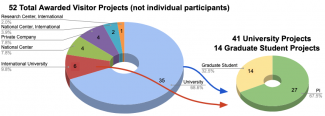Since 2004, one of the hallmarks of the Developmental Testbed Center (DTC) has been its visitor program. The DTC Visitor Program provides an opportunity for DTC staff and our operational partners to strengthen ties with the research community, which is critical to the success of the DTC’s mission. It began informally when four scientists were invited to work with us for one month over the summer on a project of their choice. The only stipulation was that it had to be consistent with the DTC’s mission. The success of that initial group of visits led to a formal program that started with one-month visits whereby those who wanted to visit submitted proposals in response to the Announcement of Opportunity (AO). Eventually, the program expanded to allow for the two-month visits offered today and the ability to submit proposals year-round. Longer visits for graduate students were also added with the aim of advancing the students’ knowledge about DTC-related work, leading to the two types of projects now supported by the program. Historically, the majority of visitors have come from universities, but visitors from research centers and private companies have also been a strong part of the program (see pie chart figures). The program has also provided the DTC with an avenue to connect with the international community.
The DTC has hosted a wide array of visitors including both projects conducted by the principal investigator (PI) and projects undertaken by a graduate student under a PI’s direction. Recent PI-led projects include a physics-based evaluation of the Hurricane Analysis and Forecast System (HAFS); an investigation of sub-grid variability and vertical overlap of partial cloudiness within the calculation of atmospheric radiative transfer, work to facilitate the transition of cutting-edge data assimilation techniques into operational NWP modeling; and the implementation of spatial dissimilarity measures into the enhanced Model Evaluation Tools (METplus) verification system.
Ivette Hernandez-Banos was a recent international student visitor who made her way to the DTC just weeks before we transitioned to working from home due to the COVID pandemic, and managed to work through the lockdown. Her success led to an additional DTC project and ultimately she took a job at NCAR in the Mesoscale and Microscale Meteorology Laboratory. Her visit formed part of her doctoral research at Centro de Previsão de Tempo e Estudos Climáticos (CPTEC)/ Instituto Nacional De Pesquisas Espaciais (INPE, Brazil) and she had many fruitful interactions with people from the DTC including Louisa Nance, Ming Hu, Guoqing Ge, Will Mayfield, and Eric Gilleland, in addition to Jacob Carley and Daryl Kleist from EMC.
Close collaboration with NOAA research and operational centers is essential for effective research-to-operation (R2O) transitions. Dr. Xuguang Wang visited EMC during her sabbatical in Fall 2018. She collaborated with EMC scientists on data-assimilation research and development. The visit expedited the transition of the capability for directly assimilating ground-based radar observation, developed by her Multiscale data Assimilation and Predictability research team, into the operational High-Resolution Rapid Refresh (HRRR) and ultimately the Hurricane Weather Research Forecast (HWRF) system.
Mike Iacono and John Henderson, who visited the DTC from industry on multiple occasions, have found their interactions with the DTC to be a rewarding opportunity as it afforded them new insights on this research topic, and successfully transitioned physics enhancements to NOAA operations. The new exponential random cloud overlap method they developed in their most recent DTC visitor project was transitioned into the 2020 operational HWRF, after testing and evaluation performed by DTC showed that it resulted in improved tropical cyclone track forecasts. This team of Iacono/Henderson split their visit into multiple shorter visits and even split them between the 2 PIs.
Obviously, the COVID pandemic made it difficult to host in-person visits, but we nevertheless were able to host visitors virtually. As the pandemic begins to wind down, we have been able to once again host visitors on-site. For example, Chong-Chi Tong and Bill Gallus were both able to join us in person last Fall as the capability for staff to work in the building again has gradually increased. Bill Gallus also has conducted multiple projects with the DTC Visitor Program, as have other individuals and teams.
It has been a very exciting and successful program that has brought many advances from research into operational use over the years, even during the pandemic. Now that our buildings and cities are starting to open back up, we’ve had an uptick in visitor applications, with two recently approved.
Past visitors have expressed appreciation, gratitude and value about their visitor project experiences. One visitor, Don Morton, proclaimed his visits to be the high points of his 30+ year career. The visitor projects are also high points for the lucky DTC staff who gain valuable knowledge and insights from these visitors. Past Visitor highlights that include project details and personal perspectives about the project can be read at DTC Newsletter | Visitors Articles. For a deeper dive, read the DTC Visitor Reports.
